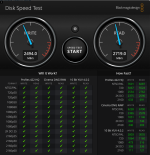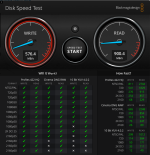EasyGoing1
Dabbler
- Joined
- Nov 5, 2021
- Messages
- 42
Hello,
... So I ALMOST pulled the trigger today on a $1200 Synology box then I stumbled on truenas.com and remembered playing around with FreeNAS back in the mid 2000's I think ... so I figured I would check it out, downloaded the ISO, and loaded it up in VMWare Fusion and I have to say I'm fairly impressed with it. Looks like it even comes with a virtual machine server built-in? Or is that just a management interface for virtual servers?
Anyway ... I want to look at specing out a small footprint box - like something similar in size to the Synology DS1621 ... or the Drobo 5 bay or the QNAP 5 bays ... that kinda size ... what's the buzz right now on that kinda hardware? The box will just be for me and my MBP 16" ... I was going to go with a 10Gbe NIC in the Synology and a Thunderbolt 3 10G adapter for the mac since Synology doesn't do or support DAS ... but perhaps it might be possible to build a truenas with a fast DAS interface instead of ethernet? After all ... thunderbolt is a heck of a lot cheaper than 10G ethernet.
Any feedback or links would be much appreciated.
Thank you,
Mike
... So I ALMOST pulled the trigger today on a $1200 Synology box then I stumbled on truenas.com and remembered playing around with FreeNAS back in the mid 2000's I think ... so I figured I would check it out, downloaded the ISO, and loaded it up in VMWare Fusion and I have to say I'm fairly impressed with it. Looks like it even comes with a virtual machine server built-in? Or is that just a management interface for virtual servers?
Anyway ... I want to look at specing out a small footprint box - like something similar in size to the Synology DS1621 ... or the Drobo 5 bay or the QNAP 5 bays ... that kinda size ... what's the buzz right now on that kinda hardware? The box will just be for me and my MBP 16" ... I was going to go with a 10Gbe NIC in the Synology and a Thunderbolt 3 10G adapter for the mac since Synology doesn't do or support DAS ... but perhaps it might be possible to build a truenas with a fast DAS interface instead of ethernet? After all ... thunderbolt is a heck of a lot cheaper than 10G ethernet.
Any feedback or links would be much appreciated.
Thank you,
Mike


